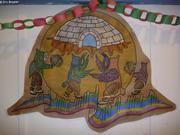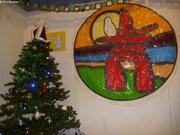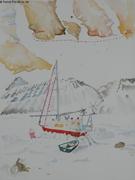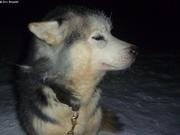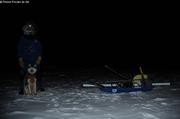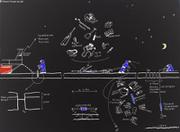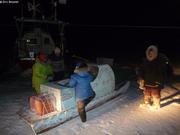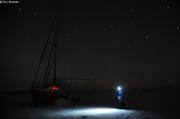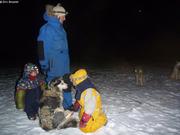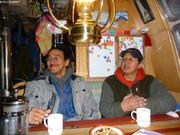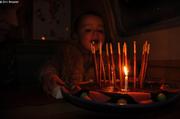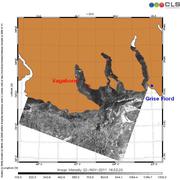Blog
Solstice
On winter solstice we are celebrating the middle of the polar night. From now on, the sun will progressively get closer to the horizon. Next sun rise expected on 15 February. But fortunately, this is not yet half of the winter! Vagabond dropped anchor at South Cape Fiord two and half months ago, she will be kept here by pack ice for another seven months or so.
France just moved the seal net, hoping for better results. She is keeping the holes open and checking the net daily. No hurry, dogs are not yet starving. On board, making gifts, candles, various decorations, biscuits... is keeping all family busy. Amazingly, just before festivities, France would already have an upset stomach, and I have a painful tooth! This will not stop us from going on Friday, if the weather is fine, to Grise Fiord, where we are invited for Christmas.
Cache cache
It is really dark today at noon, when I go for scientific measurements. Moon is set for eight days, sun is at its lowest under the horizon (winter solstice is in two days), and first of all, the sky is cloudy. On top of that, it is snowing and it is windy, so visibility is very poor. For once, I need to keep my headlamp on for the five hours field work. But luckily, I make out my tracks from previous surveys. Actually, I never had to use a GPS so far to find my way across the fjord. Once departure excitement passed, the dog Bella seems to be deep in thought too, until we meet polar bear tracks, quite recent. Hard to say as it is snowing. The animal join the "trail" and is going in front of us. Bella is sniffing actively. The sledge looks far behind, I decide to keep the riffle with me, even if I would be using the alarm pistol first. Tracks are sometimes very well marked, it is not a huge polar bear, but a fair size for now. Previously, I had watched several times polar foxes tracks, also attracted by that amazing "trail" going across the fjord. In the end, four kilometres further, we reach the iceberg near the CTD station, where I come two or three times a week. The polar bear went around, he is maybe having a nap behind, we will not go and check. On our way back, I can hardly see the light on top of Vagabond's mast, it is twinkling between snow flakes.
EM31
Why are we carrying an electromagnetic icemeter (EM31), every three days, across South Cape Fiord, for about ten kilometres? Answer by Christian Haas, professor of sea ice geophysics at University of Alberta in Edmonton (Canada):
Sea ice in the Canadian Arctic is an important component of the natural environment and human way of life and culture. It is a sensitive indicator of climate change and an obstacle for shipping and offshore operations. In order to better understand the regional and temporal variability of sea ice in the Canadian Archipelago, researchers at the University of Alberta have initiated a sea ice observing project including satellite remote sensing of ice types and developmental stages, and in situ observations of ice thickness. The program aims at repeat ice thickness surveys in the same regions every spring over several years, using electromagnetic thickness sensors towed by snow mobiles, for instance, between and around communities. The measurements in South Cape Fiord significantly contribute to these observations by providing information about the seasonal cycle of ice growth and decay, which provides a temporal context for the surveys across Jones Sound. They can also better reveal the impacts of ocean currents and stratification, as well as weather conditions on ice thicknesses measured in spring. Therefore we will include South Cape Fiord in our planned survey between Resolute Bay and Grise Fiord in May 2012.
Sur la piste avec Elvis
In order to get to know better the only male of our little dog team, today I tied Elvis to the sledge for scientific field work. Obviously, he was confused with my strange activities on pack ice. But he stayed in my tracks and pull nicely the precious sledge for about ten kilometres. In the night, by -30°C, with northerly wind, I was not talking much... maybe a good drawing would be better?
Et de 2, et de 3, et de 4 !
Elvis, Bella and Marly, brother and sisters of Unnuaq (night in Inuktitut, name given to our first dog), arrived yesterday night! Laisa and Norman played again Santa Claus: three dogs, a better seal net than our 25m long fishing net, two seals to feed the dogs, warm parkas for everyone, fruits and vegetables (grapes, tomatoes!...), stuffed animals, sweets and tooth paste (!) for the kids, and even a little Christmas tree (even so artificial). Totally unexpected visit and gifts, we are very moved with so much generosity. Also, Laisa is offering us to come to her place in town for Christmas, and our surprise guests already brought a huge sleigh to carry crew and bags from Vagabond to Grise Fiord. We only need to fill it up! Norman will try to pick up the full sleigh on 23 December, if conditions are good. No sooner had we shared a cup of tea than they left again, in the moonlight, to join the two hunters they left back on the ice. Not far from our fjord, they saw fresh tracks of a female polar bear with her two cubs.
Saturday night, not long after the beautiful moon eclipse, and while we were setting up some tinsels in the wardroom, Laisa, her husband Aksakjuk, and two young boys already turned up. It was a great pleasure to see them again, to discover all they had brought spontaneously for us (mail, fresh food, fruit juices, anorak and kamiks for Aurore...), and to listen to news from the village. Hunting is going on well (polar bear, seal, caribou, hare), the school is open again after two weeks closed because of water pipe problem, and preparations for Christmas are intensive.
Quelle nuit fait-il ?
Clear sky in the morning, stars are dimly lighting pack ice and snowy mountains around Vagabond. Some shy northern lights are adding a little colour to the scenery. At midday, without fading the stars, a soft twilight is giving an impression of light for a couple of hours. In the afternoon, the moon is taking over. Like a floodlight, she is illuminating the setting until the next day. Vagabond's mast is showing its shadow on the snow and becomes moondial. After all, polar night is not often dark! It is sometimes darker at noon than at midnight, we are loosing sleep over it.
By definition, twilight is not the same for everyone. It is the light from the sun when down to 18° below the horizon for astronomers, 12° for sailors, 6° for earthmen. Different twilights are separating people on their ability to detect light. Here at 76°27’N latitude, at noon in the middle of the polar night, the sun reaches 9° below the horizon. Almost night for sailors, dark night for earthmen. But what a light! We are flirting with astronomers privileges.
If the sky is clear on Saturday 10 December, in the morning, we will watch a full moon eclipse.
Le chien
Yesterday, two of our dogs went suddenly back to the village! We don't know yet the name of the dog we kept here, but he seems to become attached to us. He is dutifully watching our camp, and is gladly pulling the sledge full of iceberg ice or scientific equipment. He is saving time on our work, and giving real safety in the polar night, when we are focused on collecting iceberg ice for fresh water, or when doing CTD casts. He is also friendly and cheerful with the children, which is not always the case with polar dogs. Our stock of seal meat is getting low, but a net should be soon under the ice to try to catch some food for his next meals. He can't possibly fast by -35°C.
Mémorable anniversaire
Last night, around midnight, I suddenly see some light from outside. Two headlights are approaching Vagabond! Norman and Manasie managed to come all the way from Grise Fiord, one by skidoo, the other one with ATV. Packice was very thin at some places, they tell us while giving us a big box full of mail. It took them more than ten hours to cover the fifty kilometres: some technical problems with the skidoo, fragile and fractured sea ice, but above all, they had to wait for the dogs, running in their tracks! Our three new companions are not yet here. In the meantime, Norman and Manasie can have something to eat, dry the skidoo spark plugs, give us a model of harness, two chains and some seal meat for the dogs, as well as kamiks for Aurore who is having her two years old birthday today! It is a great pleasure for us all to welcome our first visitors, and to have news from town, where people are already getting ready for Christmas parties. Tired, Norman and Manasie decide to drive back to Grise Fiord, it is nearly 3am Monday morning, but the dogs are not yet here... We go to sleep for a few hours, then we are relieved to discover that the dogs arrived. As for Léonie and Aurore, they slept so well all night that they did not hear anything! Before repairing the generator with the long-awaited pump, it is time for the party we have been preparing for the last few days for Aurore.
Depuis l'espace
Packice is still not safe between Grise Fiord and Vagabond, as we can see on this view from the space. Explanations by Jean-Yves Lebras, from CLS Toulouse:
"This image is the result of ENVISAT satellite acquisition with its radar sensor ASAR (Advanced Synthetic Aperture Radar). This satellite is operated by ESA (European Space Agency).
SAR images are offering today significant potential to observe and watch marine environment. Detection of oil pollution from ships, sea state analysis, wind field, iceberg detection, sea ice chart... at unequalled space resolution, day and night.
Grey levels are representing the electromagnetic wave power received by the radar. On sea ice, power of retrodiffusion depends on ice density, surface roughness and fracturation.
Images are sent to Vagabond in the context of the European project SIDARUS, coordinated by Norwegian Institute NERSC. This project is developing new applications and new services based on satellite data in high latitudes (navigation assistance, animals movements and habitat monitoring particularly). CLS, partner of this project, is acquiring and analysing ENVISAT radar data, and then compressing and sending them to Vagabond from Brest VIGISAT station (www.vigisat.eu)."
